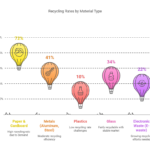As the world strides further into the 2024 labor market, a complex puzzle emerges, one that challenges industries and economies globally. The labor market, a dynamic and ever-evolving beast, is showing signs of strain in several key sectors. This section delves into the labyrinthine world of labor shortages, shedding light on the industries most acutely feeling the pinch and the underlying causes driving these trends.
The healthcare sector stands as a prominent example, grappling with a burgeoning labor gap. This shortage is not just a statistic; it’s a real-world issue with palpable impacts. An aging population, coupled with a surge in healthcare demands, has stretched this industry thin. The numbers paint a stark picture: a deficit of healthcare professionals that’s expanding rapidly. This scenario isn’t just about numbers; it’s about the real-time impacts on healthcare delivery and patient care quality.
But what’s driving this shortage? It’s a confluence of factors: an aging workforce, increased chronic disease prevalence, and a healthcare system that’s racing to keep up with technological advancements and evolving patient needs. The domino effect is clear – fewer professionals mean longer wait times, stretched resources, and a workforce teetering on the edge of burnout.
The solution to this complex problem isn’t straightforward. It involves a multifaceted approach, including ramping up training programs, exploring international recruitment, and perhaps most crucially, rethinking how healthcare is delivered. For instance, telemedicine and AI-assisted diagnostics are emerging as potential game-changers, offering new ways to deliver care efficiently.
Construction, another cornerstone industry, faces its own set of challenges. The labor shortage here is acutely felt, with a significant gap between the number of skilled workers needed and those available. The reasons? An aging workforce and a dwindling influx of new talent. The economic implications are substantial – delayed projects, increased costs, and a struggle to meet the infrastructural demands of a growing population.
The industry’s response has been innovative, to say the least. There’s a growing emphasis on vocational training programs aimed at equipping a new generation of workers with the necessary skills. Additionally, automation is increasingly seen as a critical part of the solution, potentially filling gaps in manpower and improving efficiency.
In the tech sector, the story takes a slightly different turn. Here, the labor shortage is more about specific roles – cybersecurity experts, AI specialists, and data analysts are in high demand. The sector’s rapid growth, coupled with a relentless pace of technological advancement, means that the demand for skilled professionals often outstrips supply. The education system is racing to catch up, and immigration policies are being scrutinized for their role in either alleviating or exacerbating the shortage.
Hospitality and tourism, sectors hit hard by the pandemic, are now facing a different challenge – a labor shortage as they struggle to bounce back. The shortage areas are diverse, ranging from service staff to management roles. The potential solutions being discussed are equally varied, including offering competitive wages and more flexible working conditions to attract and retain staff.
The education sector isn’t immune to labor challenges either. Teacher shortages, particularly in certain geographical areas, have profound implications for the quality of education. The causes are multifaceted, and the solutions being considered range from financial incentives to more robust support systems for educators.
Lastly, the manufacturing industry is undergoing a transformation. The labor shortage here is characterized by a gap between the existing skillsets of the workforce and the needs of an industry that’s increasingly high-tech and automated. This shift calls for a rethinking of the workforce training and development paradigm.

The Healthcare Labor Shortage: A Critical Examination
The healthcare industry, a vital sector responsible for the well-being and health of millions, is currently navigating a challenging phase marked by a significant labor shortage. This shortage is not just a transient phase but a deep-rooted issue that has implications for patient care and the healthcare system’s overall efficiency.
The Alarming Stats: A Closer Look at the Numbers
Recent studies and reports paint a concerning picture of the healthcare labor market. There’s an escalating deficit of healthcare professionals, especially in nursing and general practice. This deficit isn’t just a number; it’s a harbinger of strained services and increasing pressure on existing healthcare workers. The statistics reveal a growing gap between the number of healthcare professionals needed and those available, indicating an urgent need for action.
Unpacking the Causes: More Than Meets the Eye
The causes of this labor shortage are multifaceted. An aging population demands more healthcare services, which in turn requires more healthcare workers. Simultaneously, there’s a noticeable aging within the healthcare workforce itself, with many professionals nearing retirement. This situation is compounded by the long and demanding education and training required to enter the field, which acts as a barrier to quickly replenishing the workforce.
Patient Care at Stake: The Human Cost
The impact of this labor shortage on patient care cannot be overstated. With fewer professionals available, existing staff often face overwork and burnout, which can inadvertently affect the quality of care. In some regions, this shortage translates into longer wait times for patients and reduced access to healthcare services, underscoring the urgency of finding solutions.
Bridging the Gap: Strategies and Solutions
Addressing this shortage requires a multi-pronged approach. Increasing training and educational opportunities is crucial, as is creating more incentives for students to enter the healthcare field. Another strategy is the international recruitment of healthcare professionals, which can help fill immediate gaps. Additionally, leveraging technology and telemedicine can alleviate some of the pressures by making healthcare more efficient and accessible.
Looking Ahead: The Road to Recovery
The healthcare industry’s labor shortage is a complex issue that requires comprehensive strategies and long-term planning. Stakeholders across the board, from educational institutions to government bodies, need to collaborate to ensure that the healthcare system remains robust and capable of meeting the population’s needs.
The healthcare sector’s labor shortage is a clarion call for immediate and effective action. It’s a situation that requires not just understanding and analysis but also a committed response from all corners of the society. As the world moves forward, the collective effort to address this shortage will be a testament to the value placed on health and well-being.
Tech Sector Faces Talent Drought
The technology industry, a realm continuously reshaping our world, is grappling with a significant challenge as it heads into 2024: a glaring labor shortage, particularly in specialized roles like cybersecurity and AI development. This section delves into the trends, impacts, and potential remedies for this pressing issue.
The Rising Demand for Tech Talent
As technology becomes increasingly integral to every aspect of life and business, the demand for skilled professionals in the tech sector has surged. Cybersecurity, a field of critical importance in the digital age, faces a particularly acute shortage. With cyber threats evolving at a breakneck pace, the need for experts who can safeguard digital assets is more pressing than ever. Similarly, the burgeoning field of artificial intelligence (AI) is in dire need of skilled professionals. AI’s potential to revolutionize industries from healthcare to transportation means that the demand for specialists in this area is skyrocketing.
The Impact of Shortages
The consequences of these shortages are far-reaching. Companies struggling to find qualified cybersecurity experts are left vulnerable to increasingly sophisticated cyberattacks. This vulnerability not only poses risks to individual companies but also to the broader economy and national security. In AI, the shortage of talent impedes innovation and development, potentially slowing progress in critical areas like healthcare diagnostics, autonomous vehicles, and more.
The Role of Education and Policy
Addressing this talent shortage requires a multifaceted approach. Education systems need to adapt, focusing more on equipping students with the skills needed in these high-demand areas. This might include more specialized programs in cybersecurity and AI, as well as retraining opportunities for those looking to shift into the tech sector.
Immigration policies also play a crucial role. Many tech companies rely on skilled workers from around the world to fill these specialized roles. Streamlining visa processes and creating more pathways for skilled immigration can help alleviate the talent crunch.
Industry and Government Collaboration
The tech industry cannot tackle this challenge alone. Collaboration with government agencies is crucial. Governments can support through funding research and development in key technology areas, providing tax incentives for companies investing in training programs, and creating partnerships between industry and educational institutions to ensure curriculums align with the evolving needs of the tech sector.
Looking Ahead
As we move further into 2024, the tech industry’s labor shortage remains a significant hurdle. However, by focusing on education, policy reform, and industry-government collaboration, there is a path forward. These efforts can not only help meet the immediate needs of the tech sector but also ensure a more secure and innovative future for technology as a whole.
The Hospitality and Tourism Comeback: Navigating Labor Shortages Post-Pandemic
The hospitality and tourism industry, once at the heart of a vibrant global economy, faced unprecedented challenges during the pandemic. As the world steadily moves toward recovery, this sector is experiencing a resurgence. However, this resurgence brings its own set of challenges, chiefly a significant labor shortage that threatens to hinder its growth.

The Rising Demand for Staff in Hospitality and Tourism
As travel restrictions ease and people eagerly return to exploring and dining out, the demand for services in hospitality and tourism is skyrocketing. Hotels, restaurants, travel agencies, and recreational facilities are all experiencing a surge in customer numbers. This increase in demand is not matched by a corresponding increase in staff numbers, leading to a critical labor shortage in the industry.
Pinpointing the Shortage Areas
The labor shortage in this sector is particularly acute in service staff and management roles. With many workers having shifted to other industries during the pandemic, there’s now a gap in experienced personnel. Key positions like chefs, housekeeping staff, front desk officers, and tour operators are in high demand. Additionally, there’s a growing need for skilled management to oversee the expanding operations and ensure quality service.
The Post-Pandemic Workforce: Challenges and Opportunities
The pandemic has reshaped the expectations and preferences of the workforce. Many seek better work-life balance, higher wages, and more flexible working conditions. The hospitality and tourism industry, traditionally known for its demanding hours and lower pay scales, is thus facing a challenge in attracting and retaining talent. On the bright side, this presents an opportunity for industry leaders to innovate and rethink their employment strategies. By offering competitive wages, flexible work schedules, and growth opportunities, employers can attract the talent needed to fuel their growth.
Innovative Solutions to Tackle the Shortage
Several solutions are being implemented to address this labor crunch. Automation and technology play a critical role, with many businesses adopting digital tools for tasks like booking, customer service, and even some aspects of food preparation and room service. Training programs are being introduced to quickly upskill new staff, making it easier for people from different backgrounds to enter the industry. Additionally, there’s a growing trend of collaborating with educational institutions to create internship and training programs that prepare students for careers in hospitality and tourism.
The Road Ahead
As the hospitality and tourism industry navigates its way out of the pandemic’s shadow, adapting to the new normal of labor shortages is crucial. By embracing technological advancements, reimagining work environments, and investing in employee development, the industry can not only overcome current challenges but also lay the foundation for a more resilient and sustainable future.
Shortages in the Education Workforce
As we delve into the education sector’s labor landscape in 2024, a prominent issue surfaces – the acute shortage of teachers. This shortage is not just a number; it’s about the lives and futures of students who rely on quality education.
The Root of the Shortage
The reasons behind the teacher shortage are as diverse as they are significant. Key among them is the attrition rate – more teachers are leaving the profession than entering it. Factors such as inadequate pay, high stress levels, and a lack of professional development opportunities contribute to this exodus. Additionally, there’s a geographical imbalance, with rural areas suffering more due to less appeal for educators compared to urban settings.
The Ripple Effect
The impact of this shortage is multi-layered. Students in under-resourced schools bear the brunt, often facing larger class sizes and less experienced teachers. This can lead to a decline in educational outcomes, widening the achievement gap between different socio-economic groups. It’s a cycle that perpetuates educational inequity.
Initiatives to Revitalize Teaching
Addressing this crisis requires a multifaceted approach. Efforts are being made to make teaching a more attractive and sustainable profession. For instance, some regions are offering higher salaries, housing incentives, and student loan forgiveness to draw in and retain educators. Additionally, there’s a push towards more robust professional development and support systems for teachers, recognizing the need for career growth and satisfaction.
The Role of Technology
In this digital age, technology is also stepping up as a pivotal player. Online teaching platforms and virtual classrooms are not just pandemic-era stopgaps but are becoming integral parts of the educational landscape. They offer flexibility and access to a wider pool of teaching talent, potentially easing some of the geographical disparities.
Looking Ahead
The journey to overcoming the teacher shortage is a complex one, requiring commitment from policymakers, educational institutions, and communities. It’s about building a profession that not only attracts but also sustains its workforce. As we look towards the future, the hope is for a teaching landscape that is as diverse and dynamic as the students it serves.
Manufacturing Industry Navigates the Skills Gap
As we delve into the challenges faced by the manufacturing industry in 2024, a notable trend emerges: a growing divide between the available skill sets of the workforce and the evolving needs of the industry. This section explores this phenomenon, its implications, and potential strategies for bridging the gap.
Understanding the Skills Gap
The manufacturing industry, once a powerhouse of the global economy, is now navigating a complex landscape. Advances in technology, such as automation and artificial intelligence, have transformed the nature of manufacturing jobs. The issue at hand is not just a shortage of bodies but a gap in skills. Workers skilled in traditional manufacturing processes find themselves at a crossroads, needing to adapt to a workplace increasingly reliant on technology.
The Impact on the Workforce
The ripple effect of this skills gap is profound. Companies struggle to find workers with the necessary technical expertise, leading to a slowdown in production and innovation. The gap also poses a risk to the current workforce, whose skills may no longer align with industry demands. This situation creates a dual challenge: companies must invest in new talent while also retraining their existing employees.
Automation: A Double-Edged Sword
Automation, often viewed as a solution to labor shortages, brings its own set of challenges. While it can increase efficiency and reduce dependency on manual labor, it also necessitates a workforce skilled in managing and maintaining these automated systems. This shift demands a new kind of worker: one who is as comfortable with software as with a spanner.

Bridging the Skills Gap
Addressing this gap requires a multifaceted approach. Vocational training programs and partnerships between industry and educational institutions are key. These programs must focus not just on imparting technical skills but also on fostering adaptability and continuous learning. Companies also need to invest in training for their existing workforce, ensuring that their skills evolve alongside the industry.
The Role of Policy and Innovation
Government policies play a crucial role in shaping the future of the manufacturing workforce. Initiatives that incentivize training and education in relevant fields can help align the workforce with industry needs. Innovation in training methods, such as virtual reality simulations, can provide more effective and engaging ways to develop skills.
Looking Ahead
As we look towards the future, it’s clear that the manufacturing industry’s success hinges on its ability to adapt to these new realities. By investing in the right training and embracing innovative approaches to skill development, the industry can not only bridge the skills gap but also pave the way for a new era of manufacturing excellence.
The journey ahead for the manufacturing industry is one of adaptation and innovation. By facing the skills gap head-on and embracing new strategies for workforce development, the industry can continue to thrive in an ever-evolving global economy.
Responding with Labor Shortage Solutions
In 2024, as industries face labor shortages, RSS emerges as a practical solution, offering on-demand staffing services in sectors like transportation, logistics, warehousing, manufacturing, and industrial fields. Their approach of providing flexible and efficient staffing aligns with the need for innovative strategies in workforce management.
Education and Policy Changes: Partnering with Industry-Specific Staffing Services
Educational institutions and industries can partner with services like RSS to ensure a steady supply of trained professionals. RSS’s expertise in specific sectors complements these efforts, providing immediate staffing solutions while long-term educational and policy reforms take effect.
Technology and AI in Collaboration with Staffing Solutions
As technology and AI aid in automating and streamlining processes, staffing solutions like RSS fill in crucial gaps with skilled personnel. Their ability to provide temporary staffing complements the technological advancements, ensuring a balanced human-technology workforce.
RSS’s Role in Global Labor Strategies
RSS’s model can be adopted internationally, offering a template for global cooperation in labor solutions. Their approach demonstrates the effectiveness of flexible staffing solutions in managing the ebb and flow of labor demands across borders.
Real-World Impact: RSS in Action
- In manufacturing, RSS’s provision of skilled temporary workers helped a company maintain productivity during a critical shortage.
- RSS’s rapid deployment of logistics staff aided a distribution center in managing an unexpected surge in demand.
Future-Proofing with Agile Staffing Solutions
Incorporating services like RSS into the broader strategy of addressing labor shortages allows for agility and adaptability in workforce management. As industries look towards a future of fluctuating labor demands, partnering with a staffing solution like RSS provides a safety net, ensuring continuous operations and growth.
RSS’s staffing services offer a crucial piece in the puzzle of solving labor shortages. Their ability to provide skilled, industry-specific temporary staff on-demand is an invaluable asset for industries looking to bridge the gap in their workforce needs. As industries evolve, the collaboration between technology, education, policy reform, and staffing solutions like RSS will be key to maintaining a robust and responsive labor market.










